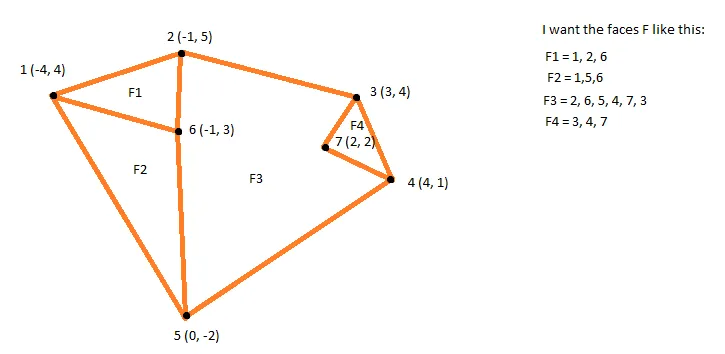我有一个平面图,是我自己创建的。我想找到这个图的面,但我找不到可行的算法来完成这个任务。到目前为止,我使用了一种算法来找到图中的所有循环,但这只给了我所有可能的循环,我尝试过但没有找到一种方法来仅仅将面排序出来。我的一个想法是使用Path2D的
运行上述代码后的结果是:
这段代码给出了以下结果,但是不需要第二到第四个。
contains方法来查看是否有另一个形状重叠,但由于面共享节点,这种方法行不通。下面的图片展示了我想要的内容,代码则展示了我的可重现示例。

import java.awt.geom.Point2D;
import java.util.ArrayList;
import java.util.Collections;
import java.util.HashSet;
import java.util.LinkedList;
import java.util.List;
import java.util.Set;
public class PolygonFinder {
// Graph modeled as list of edges
static int[][] graph
= {
{1, 2}, {1, 6}, {1, 5}, {2, 6},
{2, 3}, {3, 7}, {7, 4}, {3, 4},
{5, 4}, {6, 5}
};
static List<int[]> cycles = new ArrayList<>();
/**
* @param args
*/
public static void main(String[] args) {
for (int[] graph1 : graph) {
for (int j = 0; j < graph1.length; j++) {
findNewCycles(new int[]{graph1[j]});
}
}
cycles.stream().map(cy -> {
String s = "" + cy[0];
for (int i = 1; i < cy.length; i++) {
s += "," + cy[i];
}
return s;
}).forEachOrdered(s -> {
System.out.println(s);
});
}
static void findNewCycles(int[] path) {
int n = path[0];
int x;
int[] sub = new int[path.length + 1];
for (int[] graph1 : graph) {
for (int y = 0; y <= 1; y++) {
if (graph1[y] == n) {
x = graph1[(y + 1) % 2];
if (!visited(x, path)) // neighbor node not on path yet
{
sub[0] = x;
System.arraycopy(path, 0, sub, 1, path.length);
// explore extended path
findNewCycles(sub);
} else if ((path.length > 2) && (x == path[path.length - 1])) // cycle found
{
int[] p = normalize(path);
int[] inv = invert(p);
if (isNew(p) && isNew(inv)) {
cycles.add(p);
}
}
}
}
}
}
// check of both arrays have same lengths and contents
static Boolean equals(int[] a, int[] b) {
Boolean ret = (a[0] == b[0]) && (a.length == b.length);
for (int i = 1; ret && (i < a.length); i++) {
if (a[i] != b[i]) {
ret = false;
}
}
return ret;
}
// create a path array with reversed order
static int[] invert(int[] path) {
int[] p = new int[path.length];
for (int i = 0; i < path.length; i++) {
p[i] = path[path.length - 1 - i];
}
return normalize(p);
}
// rotate cycle path such that it begins with the smallest node
static int[] normalize(int[] path) {
int[] p = new int[path.length];
int x = smallest(path);
int n;
System.arraycopy(path, 0, p, 0, path.length);
while (p[0] != x) {
n = p[0];
System.arraycopy(p, 1, p, 0, p.length - 1);
p[p.length - 1] = n;
}
return p;
}
// compare path against known cycles
// return true, iff path is not a known cycle
static Boolean isNew(int[] path) {
Boolean ret = true;
for (int[] p : cycles) {
if (equals(p, path)) {
ret = false;
break;
}
}
return ret;
}
// return the int of the array which is the smallest
static int smallest(int[] path) {
int min = path[0];
for (int p : path) {
if (p < min) {
min = p;
}
}
return min;
}
// check if vertex n is contained in path
static Boolean visited(int n, int[] path) {
Boolean ret = false;
for (int p : path) {
if (p == n) {
ret = true;
break;
}
}
return ret;
}
}
运行上述代码后的结果是:
1,6,2
1,5,6,2
1,5,4,7,3,2
1,6,5,4,7,3,2
1,5,4,3,2
1,6,5,4,3,2
1,5,4,7,3,2,6
1,5,4,3,2,6
1,5,6
2,3,7,4,5,6
2,3,4,5,6
3,4,7
我最好的解决方法之一是使用以下代码。坐标来自顶部的图片。
List<Polygon> polys = new LinkedList<>();
Polygon p1 = new Polygon();
p1.addPoint(new Point2D.Double(-4, 4));
p1.addPoint(new Point2D.Double(-1, 3));
p1.addPoint(new Point2D.Double(-1, 5));
Polygon p2 = new Polygon();
p2.addPoint(new Point2D.Double(-4, 4));
p2.addPoint(new Point2D.Double(0, -2));
p2.addPoint(new Point2D.Double(-1, 3));
p2.addPoint(new Point2D.Double(-1, 5));
Polygon p3 = new Polygon();
p3.addPoint(new Point2D.Double(-4, 4));
p3.addPoint(new Point2D.Double(0, -2));
p3.addPoint(new Point2D.Double(4, 1));
p3.addPoint(new Point2D.Double(2, 2));
p3.addPoint(new Point2D.Double(3, 4));
p3.addPoint(new Point2D.Double(-1, 5));
Polygon p4 = new Polygon();
p4.addPoint(new Point2D.Double(-4, 4));
p4.addPoint(new Point2D.Double(-1, 3));
p4.addPoint(new Point2D.Double(0, -2));
p4.addPoint(new Point2D.Double(4, 1));
p4.addPoint(new Point2D.Double(2, 2));
p4.addPoint(new Point2D.Double(3, 4));
p4.addPoint(new Point2D.Double(-1, 5));
Polygon p5 = new Polygon();
p5.addPoint(new Point2D.Double(-4, 4));
p5.addPoint(new Point2D.Double(0, -2));
p5.addPoint(new Point2D.Double(4, 1));
p5.addPoint(new Point2D.Double(3, 4));
p5.addPoint(new Point2D.Double(-1, 5));
Polygon p6 = new Polygon();
p6.addPoint(new Point2D.Double(-4, 4));
p6.addPoint(new Point2D.Double(-1, 3));
p6.addPoint(new Point2D.Double(0, -2));
p6.addPoint(new Point2D.Double(4, 1));
p6.addPoint(new Point2D.Double(3, 4));
p6.addPoint(new Point2D.Double(-1, 5));
Polygon p7 = new Polygon();
p7.addPoint(new Point2D.Double(-4, 4));
p7.addPoint(new Point2D.Double(0, -2));
p7.addPoint(new Point2D.Double(4, 1));
p7.addPoint(new Point2D.Double(2, 2));
p7.addPoint(new Point2D.Double(3, 4));
p7.addPoint(new Point2D.Double(-1, 5));
p7.addPoint(new Point2D.Double(-1, 3));
Polygon p8 = new Polygon();
p8.addPoint(new Point2D.Double(-4, 4));
p8.addPoint(new Point2D.Double(0, -2));
p8.addPoint(new Point2D.Double(4, 1));
p8.addPoint(new Point2D.Double(3, 4));
p8.addPoint(new Point2D.Double(-1, 5));
p8.addPoint(new Point2D.Double(-1, 3));
Polygon p9 = new Polygon();
p9.addPoint(new Point2D.Double(-4, 4));
p9.addPoint(new Point2D.Double(0, -2));
p9.addPoint(new Point2D.Double(-1, 3));
Polygon p10 = new Polygon();
p10.addPoint(new Point2D.Double(-1, 5));
p10.addPoint(new Point2D.Double(3, 4));
p10.addPoint(new Point2D.Double(2, 2));
p10.addPoint(new Point2D.Double(4, 1));
p10.addPoint(new Point2D.Double(0, -2));
p10.addPoint(new Point2D.Double(-1, 3));
Polygon p11 = new Polygon();
p11.addPoint(new Point2D.Double(-1, 5));
p11.addPoint(new Point2D.Double(3, 4));
p11.addPoint(new Point2D.Double(4, 1));
p11.addPoint(new Point2D.Double(0, -2));
p11.addPoint(new Point2D.Double(-1, 3));
Polygon p12 = new Polygon();
p12.addPoint(new Point2D.Double(3, 4));
p12.addPoint(new Point2D.Double(4, 1));
p12.addPoint(new Point2D.Double(2, 2));
polys.add(p1);
polys.add(p2);
polys.add(p3);
polys.add(p4);
polys.add(p5);
polys.add(p6);
polys.add(p7);
polys.add(p8);
polys.add(p9);
polys.add(p10);
polys.add(p11);
polys.add(p12);
Set<Integer> toRemove = new HashSet<>();
for (Polygon polyI : polys) {
for (Polygon polyJ : polys) {
if (polyI.equals(polyJ)) {
continue;
}
if (polyI.contains(polyJ)) {
toRemove.add(polys.indexOf(polyI));
}
}
}
List<Integer> list = new LinkedList<>(toRemove);
Collections.sort(list);
Collections.reverse(list);
list.forEach((t) -> {
polys.remove(t.intValue());
});
System.out.println("");
polys.forEach((t) -> {
System.out.println(t.getPoints());
});
多边形方法使用如下所示。
@Override
public boolean contains(Point2D point) {
return getPath().contains(point);
}
@Override
public boolean contains(IPolygon polygon) {
List<Point2D> p2Points = polygon.getPoints();
for (Point2D point : p2Points) {
if (getPath().contains(point)) {
if (!points.contains(point)) {
return true;
}
}
}
return false;
}
private Path2D getPath() {
Path2D path = new Path2D.Double();
path.moveTo(points.get(0).getX(), points.get(0).getY());
for (int i = 1; i < points.size(); i++) {
path.lineTo(points.get(i).getX(), points.get(i).getY());
}
path.closePath();
return path;
}
这段代码给出了以下结果,但是不需要第二到第四个。
[Point2D.Double[-4.0, 4.0], Point2D.Double[-1.0, 3.0], Point2D.Double[-1.0, 5.0]]
[Point2D.Double[-4.0, 4.0], Point2D.Double[0.0, -2.0], Point2D.Double[-1.0, 3.0], Point2D.Double[-1.0, 5.0]]
[Point2D.Double[-4.0, 4.0], Point2D.Double[-1.0, 3.0], Point2D.Double[0.0, -2.0], Point2D.Double[4.0, 1.0], Point2D.Double[2.0, 2.0], Point2D.Double[3.0, 4.0], Point2D.Double[-1.0, 5.0]]
[Point2D.Double[-4.0, 4.0], Point2D.Double[0.0, -2.0], Point2D.Double[4.0, 1.0], Point2D.Double[2.0, 2.0], Point2D.Double[3.0, 4.0], Point2D.Double[-1.0, 5.0], Point2D.Double[-1.0, 3.0]]
[Point2D.Double[-4.0, 4.0], Point2D.Double[0.0, -2.0], Point2D.Double[-1.0, 3.0]]
[Point2D.Double[-1.0, 5.0], Point2D.Double[3.0, 4.0], Point2D.Double[2.0, 2.0], Point2D.Double[4.0, 1.0], Point2D.Double[0.0, -2.0], Point2D.Double[-1.0, 3.0]]
[Point2D.Double[3.0, 4.0], Point2D.Double[4.0, 1.0], Point2D.Double[2.0, 2.0]]